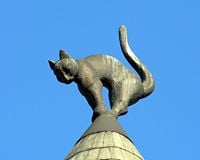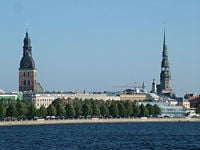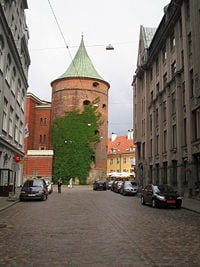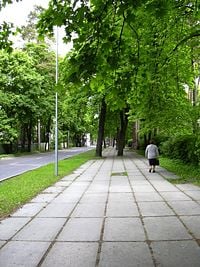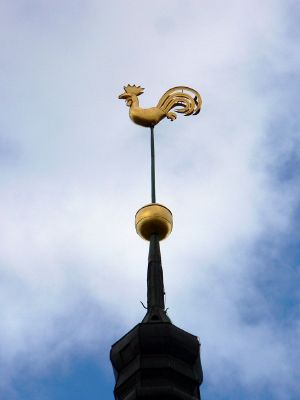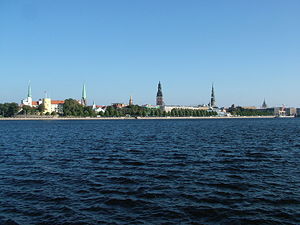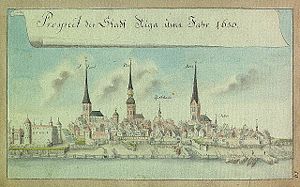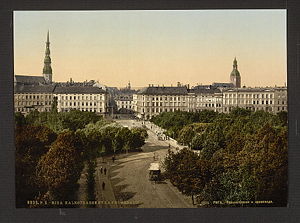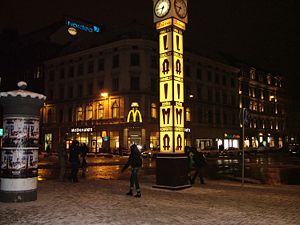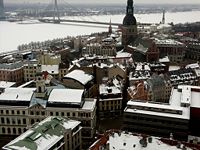Difference between revisions of "Riga, Latvia" - New World Encyclopedia
| Line 87: | Line 87: | ||
[[Image:Riga Powder Tower.JPG|thumb|200px|right|The Powder Tower of Riga]] | [[Image:Riga Powder Tower.JPG|thumb|200px|right|The Powder Tower of Riga]] | ||
[[Image:Riga street.jpg|thumb|right|200px|Left-bank Riga is distinguished by its green streets and large parks.]] | [[Image:Riga street.jpg|thumb|right|200px|Left-bank Riga is distinguished by its green streets and large parks.]] | ||
| − | + | There are more than 50 museums in the capital city of Riga, inviting one and all to learn about the history of Riga and of Latvia | |
| − | + | ||
| − | + | Riga boasts a dirverse range of museums covering history, literature, art, nature, medicine, as well as museums offering specific areas of interest. These include museams devoted to theater, cinematography, photography, television, porcelain, fire-fighting, sports, architecture, and the history of electricity. Some of Latvia’s institutions of higher education also have their own museums including the University of Latvia, the Riga Technical University and the “Turība” Business University. Riga also has a unique outdoor Latvian Ethnographic Museum on the shores of a lake just outside of the city and Mentzendorf House dedicated to showing how wealthy Rigensians lived in the 17th and 18th century.<ref>Riga Tourism Coordination | |
| − | + | and Information Centre [http://www.rigatourism.lv/EN/Channels/Tip/Info/culture/museum.htm Museums] Retrieved November 25, 2007.</ref> | |
| − | + | ||
| − | |||
| − | |||
| − | |||
| − | |||
| − | |||
| − | |||
| − | |||
| − | |||
===Art Nouveau=== | ===Art Nouveau=== | ||
| Line 123: | Line 115: | ||
===Health=== | ===Health=== | ||
===Transport=== | ===Transport=== | ||
| + | Riga as a city-port is a major transportation hub and is the center of the local road and [[railway]] system. Most tourists travel to Riga by air via [[Riga International Airport]], the largest airport in the [[Baltic states]], which was renovated and modernized in 2001 on the occasion of Riga's 800th anniversary. Air traffic at the airport has doubled between 1993 and 2004. Baltic sea ferries connect Riga to [[Stockholm]], [[Kiel]] and [[Lübeck]]. Riga was also home to two air bases during the [[Cold War]]: [[Rumbula (air base)|Rumbula]] and [[Spilve]].<Ref>www.russianairfields.com/doc/russianairfields.pdf ] Retrieved November 25, 2007.</ref> | ||
| + | |||
| + | Located on an ancient trade route between Russia and Europe, the port of Riga is an important cargo shipping center. It has connections to the Trans-Siberian rail route and direct links with Russia, other former Soviet Union countries, the rapidly growing Baltic countries, and even East Asia. It is the main all-weather port in the Baltic and is expected to grow as a result of Latvia’s return to independence in 1991, its recent admission into the EU and NATO, and increased trade with China and other ex-Soviet states.<ref> [http://riga.usembassy.gov/EN/site/R/rep20060912 ] Retrieved November 25, 2007.</ref> The Port is large, growing, and an important economic asset for Latvia. | ||
| + | |||
| + | |||
===Utilities=== | ===Utilities=== | ||
| Line 128: | Line 125: | ||
==Business and commerce== | ==Business and commerce== | ||
| − | Business and leisure travel to Riga has increased significantly in recent years due to improved infrastructure. | + | Business and leisure travel to Riga has increased significantly in recent years due to improved infrastructure. |
| − | |||
Almost all important Latvian financial institutions are located in Riga, including the [[Bank of Latvia]], which is Latvia's central bank. Foreign commercial trade through Riga has been on the increase in recent years and received new impetus on [[May 1]], [[2004]] when Latvia became a member of the [[European Union]]. Riga accounts for about half of the total industrial output of Latvia, focusing on the financial sector, public utilities, food and beverages, pharmaceuticals, wood processing, printing and publishing, textiles and furniture, and communications equipment manufacturing. More than 50% of Latvian companies are registered in Riga region.<ref>{{cite web |url=http://www.lursoft.lv/stat/ur_stat_075.html|title=Lursoft IT statistics on dynamics of registering of companies in regions of Latvia|accessdate=2007-09-25 | Almost all important Latvian financial institutions are located in Riga, including the [[Bank of Latvia]], which is Latvia's central bank. Foreign commercial trade through Riga has been on the increase in recent years and received new impetus on [[May 1]], [[2004]] when Latvia became a member of the [[European Union]]. Riga accounts for about half of the total industrial output of Latvia, focusing on the financial sector, public utilities, food and beverages, pharmaceuticals, wood processing, printing and publishing, textiles and furniture, and communications equipment manufacturing. More than 50% of Latvian companies are registered in Riga region.<ref>{{cite web |url=http://www.lursoft.lv/stat/ur_stat_075.html|title=Lursoft IT statistics on dynamics of registering of companies in regions of Latvia|accessdate=2007-09-25 | ||
}}</ref> The port of Riga is an important cargo shipping center.{{facts|date=August 2007}} | }}</ref> The port of Riga is an important cargo shipping center.{{facts|date=August 2007}} | ||
Revision as of 02:26, 26 November 2007
| Rīga | |
90px 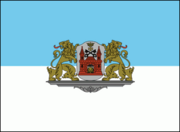
| |
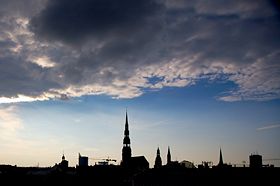
| |
| View of the old town | |
| City rights | 1201 |
|---|---|
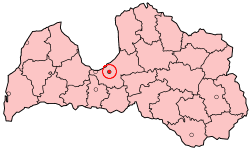
| |
| Location of Rīga within Latvia | |
| Location | 56°58′N 24°8′E |
| Other names | Estonian: Riia; Finnish: Riika; Irish: Ríge; Lithuanian: Ryga; Russian: Рига; Polish: Ryga |
| Mayor | Jānis Birks |
| Area | 307.17 km² (119 sq mi) |
| Water | 48.50 km² (19 sq mi) |
| Population | 727,578 |
| Metropolitan | 1,148,003 |
| Density | 2,382/km² (6,169/sq mi) |
| Postal code | LV-10(01-84) |
| Calling code | +371 7 |
| Time zone | EET (UTC+2) |
| Summer (DST) | EEST (UTC+3) |
| Homepage of Rīga | |
Riga the capital of Latvia, is situated on the Baltic Sea coast on the mouth of the river Daugava. Riga is the largest city in the Baltic states. The Historic Centre of Riga has been declared a UNESCO World Heritage Site, and the city is particularly notable for its extensive Art Nouveau (Jugendstil) architecture, which UNESCO considers to be unparalleled anywhere in the world [1]
History
Geography
Riga is located at 56° 58′ North and 24° 8′ East covering approximately 119 square miles (307 square kilometers).
Riga, the largest city of the Baltic States, is located on the southern shores of the Baltic Sea at the mouth of the Daugava River. The city's location, between Eastern and Western Europe, has been both a help and a hinderance to the city. It's strategic location made it aa important part of the Russian trade with Western Europe, but has also subjected it to invasion and occupation throught it 800 year history. Riga is situated on a sandy plain 9 miles (15 kilometers) from the mouth of the River Daugava and the Gulf of Riga.
Riga has large areas of natural habitat with 43.4 square miles (11,252 hectares) or over 36 percent of it's total area. This includes large-scale blocks of forests that alone cover 17% of the city. Within these natural habitat areas are bird sanctuaries and 25 protected plant species.[2]
Rivers, lakes, and other wetlands occupy an additional 17.6 percent of the total city area including 13 lakes. The largest of these lakes are Kisezers at 6.7 square miles (17.4 square kilometers) and Juglas Lake at 2.2 square miles (5.7 square kilometers). There are many minor ponds and lakes within the city and a total of 60 miles (96.4 kilometres) of rivers.[2]
Climate
Riga's close proximity to the sea results in a moderate climate with cloud cover for approximately 40 percent of the year. This maritime influence also results in higher humidity (80%) compared to the inland areas. Summers are short and cool with average July temperatures around 64°F (18°C). Winters are long, dark and cold, with January temperatures averaging around 28°F (-2°C). Snowfall is heavy and cover usually lasts from mid-December to mid-March. Total annual precipitation, including rain and snow, is 25 inches (636 millimeters).[3]
Governance
As the federal capital of the Republic of Latvia, Riga is home to both the Federal government and their local city or municipal government.
Federal
The 100-seat unicameral Latvian parliament, the Saeima, is elected by direct, popular vote every four years. The president is elected by the Saeima in a separate election also every four years. The president appoints a prime minister who, together with his cabinet, forms the executive branch of the government, which has to receive a confidence vote by the Saeima.[4]
Municipal
After independence from the Soviets in 1991, the Riga City Council became responsible for running the city. The Riga City Council (RCC) consists of 60 councillors elected to 4-year terms. Elections are held on the second Saturday in March. The number of councillors from each area is proportionate to the number of residents.[5]
Riga is divided into 6 administrative districts: Centra, Kurzemes, Latgales, Vidzemes, Zemgales, and Ziemelu.
Economy
Since regaining its independence in 1991, the city of Riga has attempted to create an open Western style economy that complies with EU standards. Immediately following separation from the Soviet Union in 1991, Riga suffered economic recession, but has managed to stabilize it's economic situation and achieve positive growth rate in 1996 (GDP growth was 2.8 percent). GDP is expected to continue to grow by approximately 5% in 2002 and the following years. Inflation has been considerably reduced and is expected to be less than 3 per cent a year. Policies fostering privatisation and the improvement of the investment climate, have contributed to increased foreign investments in the Riga area. Riga accounts for 49% of the total industrial output of Latvia.
Riga's industries include machine building, metalworking, shipbuilding and repair, textiles, woodworking and food processing. Manufacturing includes diesel engines, streetcars, chemicals, pharmaceuticals, furniture, electrical apparatus, radio and telephone equipment, meteorological instruments, printing and publishing, textiles, building materials, and paper.[6]
Recently, Riga has become the largest financial center in the Baltic Region with major banks, insurance companies and brokers located in the city. Retail trade and personal services was the first sector to show signs of recovery in the early 1990's. Wholesale and retail sales have increased from 8.7 percent of Latvia's GDP in 1994 to 16 percent in 2000. This trend is usually indicative of a growing level of consumption and an increase in the overall health of an economy.[7]
Demographics
With 722,485[8] inhabitants residing in 332,000 households[9], Riga is the largest city in the Baltic States, though its population has been on the decrease since 1991.[8] Notable causes include out-migration and low fertility rates. Some have estimated that the population may fall by as much as 50% by 2050.[10] According to the 2007 data, native Latvians make up 42.3% of the population of Riga, with the percentage of Russians at 42.1%, Belarusians at 4.4%, Ukrainians at 3.9%, Poles at 2.0%, and others at 4.3%.[11] By comparison, 59% of Latvia's inhabitants are native Latvians, 28.5% are Russians, 3.8% are Belarusians, 2.5% are Ukrainians, 2.4% are Polish, 1.4% are Lithuanians and the remaining 2.4% are accounted for by other nationalities (2006).[11] Upon restoration of Latvian independence in 1991, Soviet-era migrants (and any of their offspring born before 1991) were not automatically granted Latvian citizenship. Some have emigrated; this partially accounts for the recent decline in Riga's population. As a result of this repatriation of some Soviet-era migrants, the proportion of Latvians in Riga has increased from 36.5% in 1989 to 42.3% in 2007. In contrast the percentage of Russians has fallen from 47.3% to 42.1% in the same time period. Latvians overtook Russians as the largest ethnic group in 2006. [12]
Riga accounts for approximately one-third of Latvia's population.
Education
The total duration of general school education in Latvia is 12 years. It .
Education in Latvia begins at age seven and consists of 9-years of basic and 3 years of upper general secondary education. The 9 years of basic education consists of 4 years of primary education (sākumskola) and 5 years of lower secondary school (pamatskola). Latvian language, Mathematics, Music, Visual arts and Physical education are taught throughout the 9 years.
Upper secondary education is divided into general upper secondary education in preparation for university studies, and vocational secondary education, aimed at labour market.
Access to higher education is available to holders of a general secondary education certificate. Universities usually specify which particular subjects must be acquired in order to qualify for admission to a chosen programme and often organise one or more competitive entrance examinations with an emphasis on subjects pertinent to the chosen program.[13]
Culture
There are more than 50 museums in the capital city of Riga, inviting one and all to learn about the history of Riga and of Latvia
Riga boasts a dirverse range of museums covering history, literature, art, nature, medicine, as well as museums offering specific areas of interest. These include museams devoted to theater, cinematography, photography, television, porcelain, fire-fighting, sports, architecture, and the history of electricity. Some of Latvia’s institutions of higher education also have their own museums including the University of Latvia, the Riga Technical University and the “Turība” Business University. Riga also has a unique outdoor Latvian Ethnographic Museum on the shores of a lake just outside of the city and Mentzendorf House dedicated to showing how wealthy Rigensians lived in the 17th and 18th century.[14]
Art Nouveau
Art Nouveau is an ornamental style of art that flourished throughout Europe and the United States in the late nineteenth and early twentith centuries. It is characterized by long, sinuous, organic lines and was employed most often in architecture, interior design, jewelry and glass design. Art Nouveau originated in England and quickly spread to the European continent, where it was called Jugendstil in Germany, Sezessionstil in Austria, Stile Floreale (or Stile Liberty) in Italy, and Modernismo (or Modernista) in Spain.[15] Art Nouveau designers believed that all the arts should work in harmony to create a "total work of art," with buildings, furniture, textiles, clothes, and jewelry all conforming to the principles of Art Nouveau.
Although Art Nouveao was only popular at the end of the 19th century and at the beginning of the 20th century it left behind some extraordinary colorful architectural examples. Art Nouveau was a contrast to previous styles which required following particular historical styles. Art Nouveau stressed a complete creative freedom, an expressive flight of fantasy. Sinuous lines and geometrical ornaments, the characteristic features of Art Nouveau, divided into two main main styles, decorative and romantic nationalistic. Significant romantic nationalism Latvian architects include, E. Laube, K. Pēkšēns, A. Vanags while M. Eizenšteins created examples of decorative Art Nouveau.[16]
UNESCO's World Heritage list justification for the inclusion of Riga states "If it is evaluated for its importance in European architectural history as an assemblage of Art Nouveau/Jugendstil buildings, however, it is impossible to cite any city to compare with Riga." and "It should be noted in particular that Riga is the only ensemble on either of the Project's lists, all the remainder being individual buildings."
Arts and entertainment
Religion
Lutheranism, Roman Catholicism, and Orthodox Christianity are the most popular religions in Riga. Denominational membership statistics are self-reported and are therefore subject to varancies. In 2006, the Board of Religious Affairs recorded 1,174 congregations including Lutheran (303), Roman Catholic (250), Orthodox (118), Baptist (93), Old Believer Orthodox (67), Seventh-day Adventist (50), Jehovah's Witnesses (13), Methodist (13), Jewish (13), Buddhist (4), Muslim (15), Hare Krishna (11), Church of Jesus Christ of Latter-day Saints (Mormons) (4), and more than 100 other congregations.
There is no state religion in Latvia, however their constitution provides for a freedom of religion that is generally respected by the Government. However, bureaucratic problems still present problems for some minority religions with the Government appearing to distinguish between "traditional" (Lutheran, Roman Catholic, Orthodox, Old Believers, Baptists, and Jewish) and "new" religions.[17]
Anti-Semitism
Riga has a history of anti-semitism that still surfaces today. Jews are considered an ethnic group in Latvia, similar to Latvian or Russian, rather than a religion. The Jewish community, once estimated to be between 6,000 to 13,500 persons was virtually destroyed in the Holocaust during the 1941-1944 German occupation.
Descrations of Jewish sites continue with several recent incidents including the overturning of tombstones and spraying of anti-Semitic graffiti on the walls of Riga's New Jewish Cemetery. Although the damage was quickly repaired and National leaders condemned the act, there were similar acts of vandalism in both 2004 and 2005. Also in seperate incidents in 2005, the Orthodox rabbi of Riga was accosted, threatened, and subjected to violently anti-Semitic epithets and vandals deliberately knocked over and broke a large outdoor menorah during the Jewish Hanukkah holiday.[17]
Infrastructure
Health
Transport
Riga as a city-port is a major transportation hub and is the center of the local road and railway system. Most tourists travel to Riga by air via Riga International Airport, the largest airport in the Baltic states, which was renovated and modernized in 2001 on the occasion of Riga's 800th anniversary. Air traffic at the airport has doubled between 1993 and 2004. Baltic sea ferries connect Riga to Stockholm, Kiel and Lübeck. Riga was also home to two air bases during the Cold War: Rumbula and Spilve.[18]
Located on an ancient trade route between Russia and Europe, the port of Riga is an important cargo shipping center. It has connections to the Trans-Siberian rail route and direct links with Russia, other former Soviet Union countries, the rapidly growing Baltic countries, and even East Asia. It is the main all-weather port in the Baltic and is expected to grow as a result of Latvia’s return to independence in 1991, its recent admission into the EU and NATO, and increased trade with China and other ex-Soviet states.[19] The Port is large, growing, and an important economic asset for Latvia.
Utilities
Business and commerce
Business and leisure travel to Riga has increased significantly in recent years due to improved infrastructure. Almost all important Latvian financial institutions are located in Riga, including the Bank of Latvia, which is Latvia's central bank. Foreign commercial trade through Riga has been on the increase in recent years and received new impetus on May 1, 2004 when Latvia became a member of the European Union. Riga accounts for about half of the total industrial output of Latvia, focusing on the financial sector, public utilities, food and beverages, pharmaceuticals, wood processing, printing and publishing, textiles and furniture, and communications equipment manufacturing. More than 50% of Latvian companies are registered in Riga region.[20] The port of Riga is an important cargo shipping center.
History
| Historic Centre of Riga* | |
|---|---|
| UNESCO World Heritage Site | |
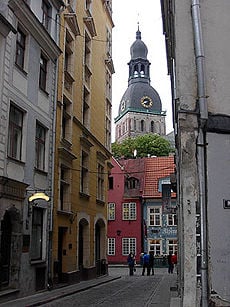
| |
| Type | Cultural |
| Criteria | i, ii |
| Reference | 852 |
| Region** | Europe and North America |
| Inscription history | |
| Inscription | 1997 (21st Session) |
| * Name as inscribed on World Heritage List. ** Region as classified by UNESCO. | |
Riga is located at the site of an ancient settlement of the Livonians, an ancient Finnic tribe, at the junction of the Daugava and Ridzene (Latvian: Rīdzene) rivers. The Ridzene was originally known as the Riga River, at one point forming a natural harbor called the Riga Lake, neither of which exist today [21]. Some believe that the name of the river gave Riga its name.[citation needed]
The modern founding of Riga is regarded by historians to have begun with the arrival in Latvia of German traders, mercenaries and religious crusaders in the second half of the 12th century, attracted by a sparsely populated region, potential new markets and by the missionary opportunities to convert the local population to Christianity. German merchants established an outpost for trading with the Balts near the Liv settlement at Riga in 1158. The Augustinian monk Meinhard built a monastery there ca. 1190.
Bishop Albert was proclaimed Bishop of Livonia by his uncle Hartwig, Archbishop of Bremen and Hamburg in 1199. He landed in Riga in 1201 with 23 ships and more than 1500 armed crusaders, making Riga his bishopric. He established the Order of Livonian Brothers of the Sword (later a branch of the Teutonic Knights) and granted Riga city rights in that same year. Albert was successful in converting the King of the Livs, Caupo of Turaida, to Christianity, although, as related in the Chronicle of Henry of Livonia ("Henricus Lettus"), it took him three decades to gain full control of Livonia (German Livland). Riga as well as Livonia and Prussia came under the auspices of the Holy Roman (German) Empire. It was not until much later, at the time of Martin Luther, that Riga, Livonia and Prussia converted to Protestantism.
Riga served as a gateway to trade with the Baltic tribes and with Russia. In 1282 Riga became a member of the Hanseatic League (German Hanse, English Hansa). The Hansa developed out of an association of merchants into a loose trade and political union of North German and Baltic cities and towns. Due to its economic protectionist policies which favored its German members, the League was very successful, but its exclusionist policies produced competitors. Its last Diet convened in 1669, although its powers were already weakened by the end of the 14th century, when political alliances between Lithuania and Poland and between Sweden, Denmark and Norway limited its influence. Nevertheless, the Hansa was instrumental in giving Riga economic and political stability, thus providing the city with a strong foundation which endured the political conflagrations that were to come, down to modern times.
As the influence of the Hansa waned, Riga became the object of foreign military, political, religious and economic aspirations. Riga accepted the Reformation in 1522, ending the power of the archbishops. In 1524, a venerated statue of the Virgin Mary in the Cathedral was denounced as a witch, and given a trial by water in the Daugava or Dvina River. The statue floated, so it was denounced as a witch and burnt at Kubsberg[22]. With the demise of the Teutonic Knights in 1561, Riga for twenty years had the status of a Free Imperial City, then in 1581, Riga came under the influence of the Polish-Lithuanian Commonwealth. Attempts to reinstitute Roman Catholicism in Riga and southern Livonia failed as in 1621, Riga and the outlying fortress of Daugavgriva came under the rule of Gustavus Adolphus, King of Sweden, who intervened in the Thirty Years' War not only for political and economic gain but also in favor of German Lutheran Protestantism. During the Russo-Swedish War, 1656-1658, Riga withstood a siege by Russians. Riga remained the second largest city under Swedish control until 1710 during a period in which the city retained a great deal of self-government autonomy. In that year, in the course of Great Northern War, Russia under Tsar Peter the Great invaded Riga. Sweden's northern dominance ended, and Russia's emergence as the strongest Northern power was formalized through the Treaty of Nystad in 1721. Riga was annexed by Russia and became an industrialized port city of the Russian empire, where it remained until World War I. By 1900, Riga was the third largest city in Russia after Moscow and St. Petersburg in terms of numbers of industrial workers.
During these many centuries of war and changes of power in the Baltic, the Baltic Germans in Riga, successors to Albert's merchants and crusaders, clung to their dominant position despite demographic changes. Riga even employed German as its official language of administration until the imposition of Russian language in 1891 as the official language in the Baltic provinces. All birth, marriage and death records were kept in German up to that year. Latvians began to supplant Germans as the largest ethnic group in the city in the mid-19th century, however, and by 1897 the population was 45% Latvian (up from 23.6% in 1867), 23.8% German (down from 42.9% in 1867), 16.1% Russian, 6% Jewish, 4.8% Polish, 2.3% Lithuanian, and 1.3% Estonian.[citation needed] The rise of a Latvian bourgeoisie made Riga a center of the Latvian National Awakening with the founding of the Riga Latvian Association in 1868 and the organization of the first national song festival in 1873. The nationalist movement of the Young Latvians was followed by the socialist New Current during the city's rapid industrialization, culminating in the 1905 Revolution led by the Latvian Social Democratic Workers' Party.
The 20th century brought World War I and the impact of the Russian Revolution to Riga. The German army marched into Riga in 1917. In 1918 the Treaty of Brest-Litovsk was signed giving the Baltic countries to Germany. Because of the Armistice with Germany (Compiègne) of November 11, 1918, Germany had to renounce that treaty, as did Russia, leaving Latvia and the other Baltic States in a position to claim independence.
After more than 700 years of German, Swedish, Russian rule, Latvia, with Riga as its capital city, thus declared its independence on November 18, 1918. For more details, see History of Latvia.
Between World War I and World War II (1918–1940), Riga and Latvia shifted their focus from Russia to the countries of Western Europe. A democratic, parliamentary system of government with a President was instituted. Latvian was recognized as the official language of Latvia. Latvia was admitted to the League of Nations. The United Kingdom and Germany replaced Russia as Latvia's major trade partners. As a sign of the times, Latvia's first Prime Minister, Kārlis Ulmanis, had studied agriculture and worked as a lecturer at the University of Nebraska in the United States of America.
Riga was described at this time as a vibrant, grand and imposing city and earned the title of "Paris of the North" from its visitors.
This period of rebirth was short-lived, however. Democracy faltered, and in 1934, Ulmanis staged a coup d´état that installed an authoritiarian regime. There then followed World War II, with the Soviet occupation and annexation of Latvia in 1940, German occupation in 1941-1944. The Baltic Germans were forcibly repatriated to Germany at Hitler's behest, after 700 years in Riga. The city's Jewish community was forced into a ghetto in the Maskavas neighbourhood, and concentration camps were constructed in Kaiserwald and at nearby Salaspils.
Nazism was defeated, but the effects of the war were lasting. Aside from the destruction is wrought, the war cost Latvia dearly. Hundreds of thousands of her citizens had perished and tens of thousands fled into exile in countries all over the world. As a result of World War II, Latvia lost approximately one-third of its population.
Furthermore, instead of re-established independence, in 1945 Latvia was once again subjected to Soviet domination. Many Latvians were deported to Siberia and other regions of the Soviet Union, usually bineg accused of having collaborated with the Nazis or of supporting the post-war anti-Soviet Resistance. Forced industrialization and planned large-scale immigration of large numbers of non-Latvians from other Soviet republics into Riga, particularly Russians, changed the demographic composition of Riga. High-density apartment developments, such as Purvciems, Zolitude, and Ziepniekkalns ringed the city's edge, linked to the center by electric railways. By 1975 less than 40% of Riga's inhabitants were ethnically Latvian, a percentage which has risen since Latvian independence.
In 1986 the modern landmark of Riga, the Riga Radio and TV Tower, whose design is reminiscent of the Eiffel Tower,[citation needed] was completed.
The policy of economic reform introduced as Perestroika by Soviet leader Mikhail Gorbachev led to a situation in the late 1980s in which many Soviet republics, including Latvia, were able to regain their liberty and freedom (see Latvia). Latvia declared its full de facto independence on August 21, 1991 and that independence was recognized by Russia on September 6, 1991. Latvia formally joined the United Nations as an independent country on September 17, 1991. All Russian military forces were removed from 1992 to 1994.
- In 2001, Riga celebrated its 800th anniversary as a city.
- On March 29, 2004 Latvia joined NATO.
- On May 1, 2004 Latvia joined the European Union.
In 2004, the arrival of low-cost airlines resulted in cheaper flights from other European cities such as London and Berlin and consequently a substantial increase in numbers of tourists. [23] However concerns have been expressed about the misbehaviour of some groups of tourists after two British tourists were caught urinating in Freedom Monument Square[24] prompting the British embassy to issue advice to tourists to behave in a responsible way when drinking. [25] The number of tourists has continued to increase and 2006 saw an 18% rise in the number of people staying in Latvian hotels relative to 2005, the largest increase in the E.U. and well above the European average of 2.4%. [26]
Sister cities
Riga maintains sister city relationships with the following cities:
Notes
- ↑ Unesco World Heritage ListRiga (Page 67) Retrieved November 24, 2007.
- ↑ 2.0 2.1 Cities Environment Reports on the Internet Natural heritage Retrieved November 24, 2007.
- ↑ Globe Media Ltd. Riga Retrieved November 24, 2007.
- ↑ (Latvian)Constitution of the Republic of Latvia with amendments and revisions (Official english translation) (Retrieved on 24 December 2006)
- ↑ Municipality of Riga Riga City Council Retrieved november 24, 2007.
- ↑ The Columbia Electronic Encyclopedia, Sixth Edition Riga Retrieved November 24, 2007
- ↑ Cities Environment Reports on the Internet Riga City Environment Centre "Agenda 21" Retrieved November 24, 2007.
- ↑ 8.0 8.1 Central Statistical Bureau of Latvia Resident Population by Region Retrieved November 24, 2007.
- ↑ Cities Environment Reports on the Internet Population Retrieved November 24, 2007.
- ↑ Heleniak, Timothy (February 2006). Latvia Looks West, But Legacy of Soviets Remains. University of Maryland. Retrieved 2007-08-02.
- ↑ 11.0 11.1 Riga in Figures. Riga City Council. Retrieved 2007-08-02.
- ↑ RESIDENT POPULATION BY ETHNICITY AT THE BEGINNING OF THE YEAR.
- ↑ Ministry of Education and Science Education in Latvia Retrieved November 24, 2007.
- ↑ Riga Tourism Coordination and Information Centre Museums Retrieved November 25, 2007.
- ↑ Encyclopædia Britannica Art Nouveau Retrieved November 25, 2007
- ↑ Riga City Council Art Nouveau Retrieved November 25, 2007.
- ↑ 17.0 17.1 U.S. Embassy Riga, LatviaInternational Religious Freedom Report - Latvia, 2006 Retrieved November 24, 2007.
- ↑ www.russianairfields.com/doc/russianairfields.pdf ] Retrieved November 25, 2007.
- ↑ [1] Retrieved November 25, 2007.
- ↑ Lursoft IT statistics on dynamics of registering of companies in regions of Latvia. Retrieved 2007-09-25.
- ↑ Teritorija un administratīvās robežas vēsturiskā skatījumā (in Latvian). Cities Environmental Reports on the Internet. Retrieved 2007-08-02.
- ↑ MacCulloch, Diarmaid (2003). The Reformation: A History. Penguin. ISBN 0-670-03296-4.
- ↑ Charles, Jonathan, "Latvia prepares for a tourist invasion", BBC News, 2005-06-30. Retrieved 2007-08-02.
- ↑ "UK tourist urinates in Freedom Monument square", The Baltic Times, 2007-05-21. Retrieved 2007-08-02.
- ↑ "British embassy warns tourists in Latvia: think before you drink", Monsters and Critics, 2007-03-15. Retrieved 2007-08-02.
- ↑ Baltic Outlook, August 2007, p56
Sources and further reading
External links
Credits
New World Encyclopedia writers and editors rewrote and completed the Wikipedia article in accordance with New World Encyclopedia standards. This article abides by terms of the Creative Commons CC-by-sa 3.0 License (CC-by-sa), which may be used and disseminated with proper attribution. Credit is due under the terms of this license that can reference both the New World Encyclopedia contributors and the selfless volunteer contributors of the Wikimedia Foundation. To cite this article click here for a list of acceptable citing formats.The history of earlier contributions by wikipedians is accessible to researchers here:
The history of this article since it was imported to New World Encyclopedia:
Note: Some restrictions may apply to use of individual images which are separately licensed.
